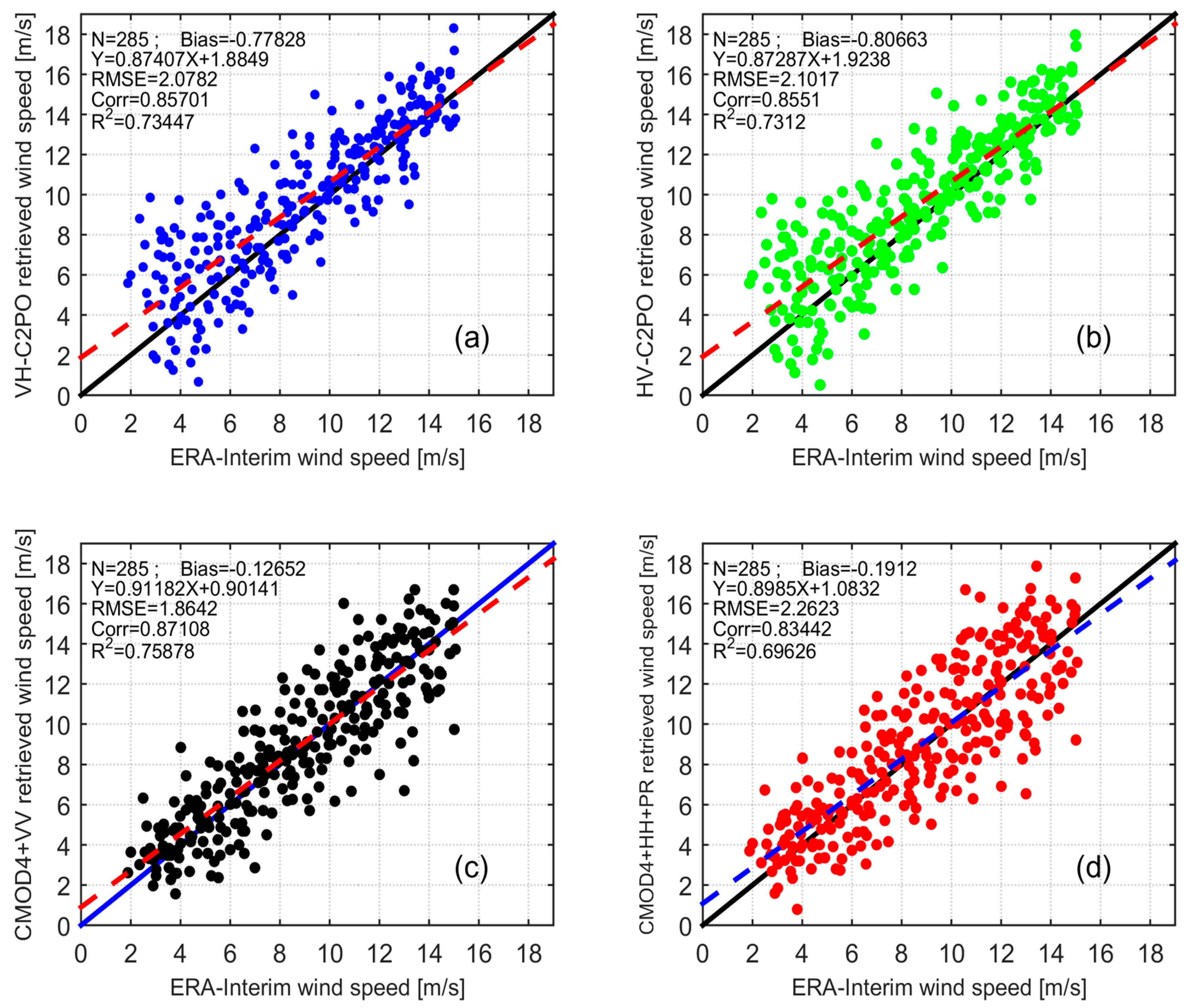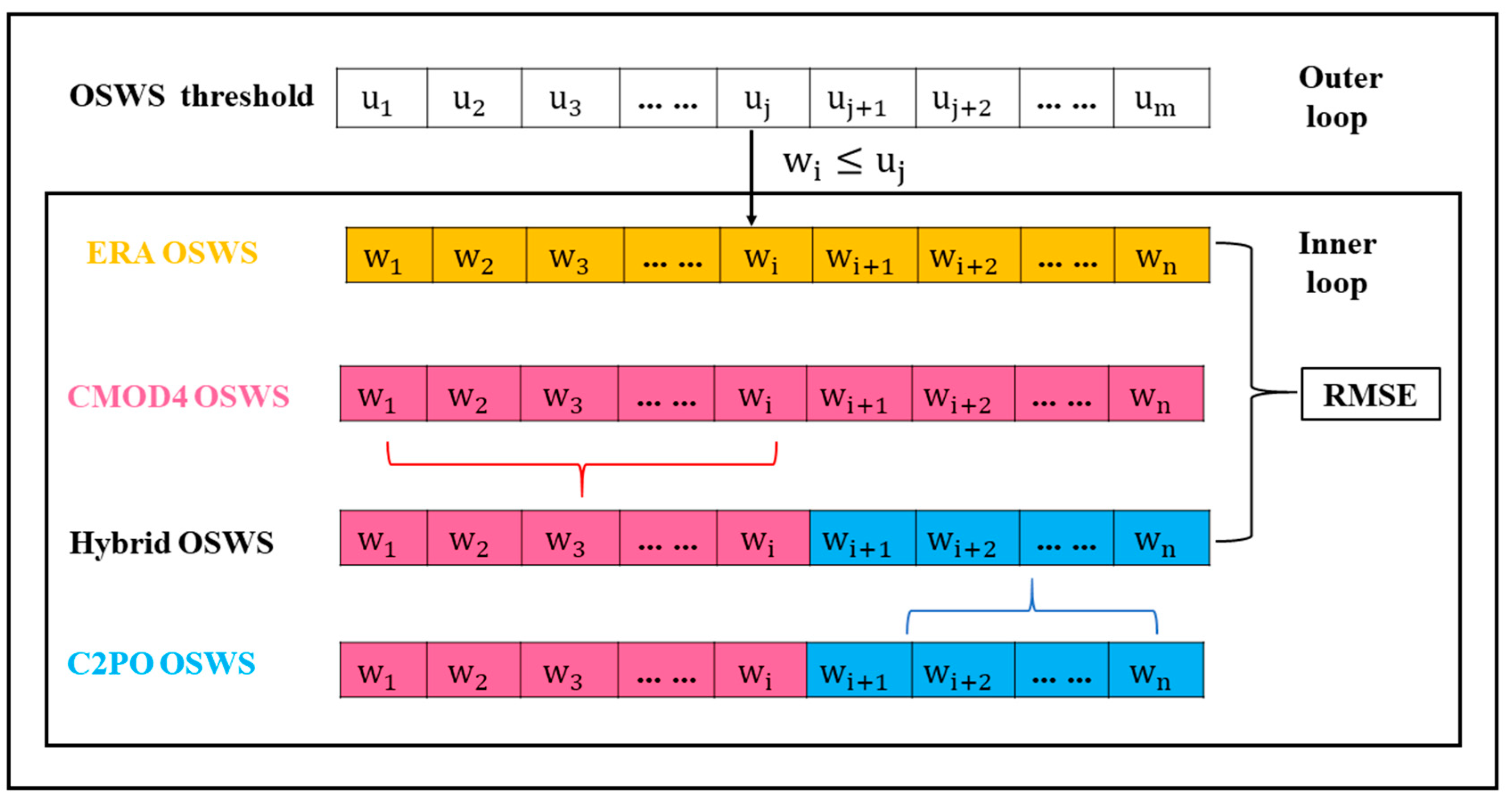Comparison of C-Band Quad-Polarization Synthetic Aperture Radar Wind Retrieval Models
Abstract
:1. Introduction
2. Materials and Methods
2.1. RADARSAT-2 Quad-Polarized SAR Images
2.2. ECMWF ERA-Interim Reanalysis Winds
2.3. Creation of Wind Speed Databases
2.4. Quad-Polarized SAR Wind Speed Retrieval Algorithm
3. Results
3.1. OSWS Retrieval Case
3.2. OSWS Retrieval Using Training Database
3.3. Different between C-2PO and CMOD4 GMF OSWS Retrievals
4. Discussion
4.1. A Hybrid OSWS Retrieval Algorithm Using Quad-Polarized RS-2 SAR Data
4.1.1. Methodology for Precise OSWS Threshold Based on the Training Dataset
- (1)
- Create three one-dimensional arrays of wind speeds (OSWS): ERA-Interim, retrieved from C-2PO and retrieved from CMOD4. These three arrays have the same number of elements and one-to-one correspondence to the ERA-Interim OSWS.
- (2)
- Calculate the maximum, minimum and length of the ERA-Interim array and denote as max_ERA, min_ERA and n, respectively;
- (3)
- Set up OSWS threshold array from min_ERA to max_ERA in steps of 0.05 and with m as the length of these arrays.
- (4)
- Design a double loop program. The outer loop variable is j from 1 to m and the inner loop variable is i from 1 to n;
- (5)
- In the outer loop, the OSWS threshold value ranges from min_ERA to max_ERA in steps of 0.05 m/s. In the inner loop, we compute a new one-dimensional array when the threshold is a constant, called the hybrid OSWS array, depending on the follow rule: we select CMOD4 retrieved OSWS when ERA-Interim OSWS less than or equal to the reference OSWS; otherwise, we select the C-2PO retrieved OSWS, when ERA-Interim OSWS greater than the reference array; then, compute RMSEs between ERA-Interim OSWS and the hybrid OSWS array.
- (6)
- Find the position of the minimum RMSE value. The reference array element corresponding to this position is the best threshold value. Figure 8 shows a sketch of this method.
4.1.2. Establishment and Validation of the Hybrid OSWS Retrieval Model
4.2. Error Analysis of OSWS Retrieved Using C-2PO Model at Low-to-Moderate Winds
4.2.1. Effect of Modeling the Data from C-2PO
4.2.2. Effect of the Noise Level
4.2.3. Effect of the Wind-Roughness Relationship
4.2.4. Effect of the Reconstructed Spatial Resolution
5. Conclusions
Author Contributions
Funding
Acknowledgments
Conflicts of Interest
References
- Monaldo, F.M.; Li, X.; Pichel, W.G.; Jackson, C.R. Ocean wind speed climatology from spaceborne SAR imagery. Bull. Am. Meteorol. Soc. 2014, 95, 565–569. [Google Scholar] [CrossRef]
- Duan, B.; Zhang, W.; Yang, X. Assimilation of Typhoon Wind Field Retrieved from Scatterometer and SAR Based on the Huber Norm Quality Control. Remote Sens. 2017, 9, 987. [Google Scholar] [CrossRef]
- Xie, T.; Perrie, W.; He, Y.; Li, H.; Fang, H.; Zhao, S.; Yu, W. Ocean surface wave measurements from fully polarimetric SAR imagery. Sci. China Earth Sci. 2015, 58, 1849–1861. [Google Scholar] [CrossRef]
- Shen, H.; Perrie, W.; He, Y.; Liu, G. Wind speed retrieval from VH dual-polarization RADARSAT-2 SAR images. IEEE Trans. Geosci. Remote Sens. 2014, 52, 5820–5826. [Google Scholar] [CrossRef]
- Fang, H.; Xie, T.; Perrie, W.; Zhao, L.; Yang, J.; He, Y. Ocean Wind and Current Retrievals Based on Satellite SAR Measurements in Conjunction with Buoy and HF Radar Data. Remote Sens. 2017, 9, 1321. [Google Scholar] [CrossRef]
- Denbina, M.; Collins, M.J. Wind speed estimation using C-band compact polarimetric SAR for wide swath imaging modes. ISPRS J. Photogramm. Remote Sens. 2016, 113, 75–85. [Google Scholar] [CrossRef]
- Liu, G.; Yang, X.; Li, X.; Zhang, B.; Pichel, W.; Li, Z.; Zhou, X. A systematic comparison of the effect of polarization ratio models on sea surface wind retrieval from C-band synthetic aperture radar. IEEE J. Sel. Top. Appl. Earth Obs. Remote Sens. 2013, 6, 1100–1108. [Google Scholar] [CrossRef]
- Jagdish; Kumar, S.; Chakraborty, A.; Kumar, R. Validation of wind speed retrieval from RISAT-1 SAR images of the North Indian Ocean. Remote Sens. Lett. 2018, 9, 421–428. [Google Scholar] [CrossRef]
- Stoffelen, A.; Anderson, D. Scatterometer data interpretation: Derivation of the transfer function CMOD4. J. Geophys. Res. 1997, 102, 5767–5780. [Google Scholar] [CrossRef]
- Quilfen, Y.; Chapron, B.; Elfouhaily, T.; Katsaros, K.; Tournadre, J. Observation of tropical cyclones by high-resolution scatterometry. J. Geophys. Res. 1998, 103, 7767–7786. [Google Scholar] [CrossRef] [Green Version]
- Hersbach, H.; Stoffelen, A.; Haan, S. An improved C-band scatterometer ocean geophysical model function: CMOD5. J. Geophys. Res. Oceans 2007, 112, C03006. [Google Scholar] [CrossRef]
- Mouche, A.; Chapron, B.; Zhang, B.; Husson, R. Combined Co- and Cross-Polarized SAR Measurements under Extreme Wind Conditions. IEEE Trans. Geosci. Remote Sens. 2017, 55, 6746–6755. [Google Scholar] [CrossRef]
- Stoffelen, A.; Verspeek, J.A.; Vogelzang, J.; Verhoef, A. The CMOD7 geophysical model function for ASCAT and ERS wind retrievals. IEEE J. Sel. Top. Appl. Earth Obs. Remote Sens. 2017, 10, 2123–2134. [Google Scholar] [CrossRef]
- Thompson, D.R.; Elfouhaily, T.M.; Chapron, B. Polarization ratio for microwave backscattering from the ocean surface at low to moderate incidence angles. In Proceedings of the 1998 IEEE International Geoscience and Remote Sensing Symposium Proceedings (IGARSS’98), Seattle, WA, USA, 6–10 July 1998; Volume 3, pp. 1671–1673. [Google Scholar]
- Vachon, P.W.; Dobson, F.W. Wind retrieval from RADARSAT SAR images: Selection of a suitable C-band HH polarization wind retrieval model. Can. J. Remote Sens. 2000, 26, 306–313. [Google Scholar] [CrossRef]
- Horstmann, J.; Koch, W.; Lehner, S.; Tonboe, R. Wind retrieval over the ocean using synthetic aperture radar with C-band HH polarization. IEEE Trans. Geosci. Remote Sens. 2000, 38, 2122–2131. [Google Scholar] [CrossRef]
- Mouche, A.A.; Hauser, D.; Daloze, J.F.; Guerin, C. Dual-polarization measurements at C-band over the ocean: Results from airborne radar observations and comparison with ENVISAT ASAR data. IEEE Trans. Geosci. Remote Sens. 2005, 43, 753–769. [Google Scholar] [CrossRef]
- Johnsen, H.; Engen, G.; Guitton, G. Sea-surface polarization ratio from Envisat ASAR AP data. IEEE Trans. Geosci. Remote Sens. 2008, 46, 3637–3646. [Google Scholar] [CrossRef]
- Shen, H.; Perrie, W.; He, Y. On SAR wind speed ambiguities and related geophysical model functions. Can. J. Remote Sens. 2009, 35, 310–319. [Google Scholar] [CrossRef]
- Zhang, B.; Perrie, W.; He, Y. Wind speed retrieval from RADARSAT-2 quad-polarization images using a new polarization ratio model. J. Geophys. Res. Atmos. 2011, 116. [Google Scholar] [CrossRef] [Green Version]
- Hwang, P.A.; Zhang, B.; Toporkov, J.V.; Perrie, W. Comparison of composite Bragg theory and quad-polarization radar backscatter from RADARSAT-2, with applications to wave breaking and high wind retrieval. J. Geophys. Res. Oceans 2010, 115. [Google Scholar] [CrossRef]
- Hwang, P.A.; Perrie, W.; Zhang, B. Cross-polarization radar backscattering from the ocean surface and its dependence on wind velocity. IEEE Trans. Geosci. Remote Sens. Lett. 2014, 11, 2188–2192. [Google Scholar] [CrossRef]
- Vachon, P.W.; Wolfe, J. C-band cross-polarization wind speed retrieval. IEEE Trans. Geosci. Remote Sens. Lett. 2011, 8, 456–458. [Google Scholar] [CrossRef]
- Zhang, B.; Perrie, W.; Vachon, P.W.; Li, X.; Pichel, W.G.; Guo, J.; He, Y. Ocean vector winds retrieval from C-band fully polarimetric SAR measurements. IEEE Trans. Geosci. Remote Sens. 2012, 50, 4252–4261. [Google Scholar] [CrossRef]
- Zhang, B.; Perrie, W. Cross-polarized synthetic aperture radar: A new potential technique for hurricanes. Bull. Am. Meteorol. Soc. 2012, 93, 531–541. [Google Scholar] [CrossRef]
- Horstmann, J.; Falchetti, S.; Wackerman, C.; Maresca, S.; Caruso, M.J.; Graber, H.C. Tropical cyclone winds retrieved from C-band cross-polarized synthetic aperture radar. IEEE Trans. Geosci. Remote Sens. 2015, 53, 2887–2898. [Google Scholar] [CrossRef]
- Zhang, G.; Li, X.; Perrie, W.; Hwang, P.A.; Zhang, B.; Yang, X. A Hurricane Wind Speed Retrieval Model for C-Band RADARSAT-2 Cross-Polarization ScanSAR Images. IEEE Trans. Geosci. Remote Sens. 2017, 55, 4766–4774. [Google Scholar] [CrossRef]
- Touzi, R.; Vachon, P.W.; Wolfe, J. Requirement on antenna cross-polarization isolation for the operational use of C-band SAR constellations in maritime surveillance. IEEE Trans. Geosci. Remote Sens. 2010, 7, 861–865. [Google Scholar] [CrossRef]
- La, T.V.; Khenchaf, A.; Comblet, F.; Nahum, C. Assessment of Wind Speed Estimation from C-Band Sentinel-1 Images Using Empirical and Electromagnetic Models. IEEE Trans. Geosci. Remote Sens. 2018, 56, 4075–4087. [Google Scholar] [CrossRef]
- Lehner, S.; Schulz-Stellenfleth, J.; Schattler, B.; Breit, H.; Horstmann, J. Wind and wave measurements using complex ERS-2 SAR wave mode data. IEEE Trans. Geosci. Remote Sens. 2000, 38, 2246–2257. [Google Scholar] [CrossRef]
- Horstmann, J.; Schiller, H.; Schulz-Stellenfleth, J.; Lehner, S. Global wind speed retrieval from SAR. IEEE Trans. Geosci. Remote Sens. 2003, 41, 2277–2286. [Google Scholar] [CrossRef] [Green Version]
- Carvalho, D.; Rocha, A.; Gómez-Gesteira, M. Ocean surface wind simulation forced by different reanalyses: Comparison with observed data along the Iberian Peninsula coast. Ocean Model. 2012, 56, 31–42. [Google Scholar] [CrossRef]
- Dee, D.P.; Uppala, S.M.; Simmons, A.J.; Berrisford, P.; Poli, P.; Kobayashi, S.; Andrae, U.; Alonso-Balmaseda, M.; Balsamo, G.; Bauer, P.; et al. The ERA-Interim reanalysis: Configuration and performance of the data assimilation system. Q. J. R. Meteorol. Soc. 2011, 137, 553–597. [Google Scholar] [CrossRef]
- Xu, Q.; Lin, H.; Li, X.F.; Zheng, Q.; Pichel, W.; Liu, Y. Assessment of an analytical model for sea surface wind speed retrieval from spaceborne SAR. Int. J. Remote Sens. 2010, 31, 993–1008. [Google Scholar] [CrossRef]
- Komarov, A.; Zabeline, V.; Barber, D. Ocean surface wind speed retrieval from C-band SAR images without wind direction input. IEEE Trans. Geosci. Remote Sens. 2014, 52, 980–990. [Google Scholar] [CrossRef]
- Han, B.; Xu, X.; Li, H. Wind Speed Retrieval of Ocean Surface Using Radarsat-2 Co-polarization Data. Remote Sens. Technol. Appl. 2017, 32, 419–426. [Google Scholar]
- Kudryavtsev, V.; Hauser, D.; Caudal, G.; Chapron, B. A semiempirical model of the normalized radar cross-section of the sea surface 1. Background model. J. Geophys. Res. 2003, 108. [Google Scholar] [CrossRef] [Green Version]
- Zhang, G.; Perrie, W.; Li, X.; Zhang, J.A. A hurricane morphology and sea surface wind vector estimation fmodel based on C-band cross-polarization SAR imagery. IEEE Trans. Geosci. Remote Sens. 2017, 55, 1743–1751. [Google Scholar] [CrossRef]
- Zhang, K.; Xu, X.; Han, B.; Mansaray, L.R.; Guo, Q.; Huang, J. The Influence of Different Spatial Resolutions on the Retrieval Accuracy of Sea Surface Wind Speed with C-2PO Models Using Full Polarization C-Band SAR. IEEE Trans. Geosci. Remote Sens. 2017, 55, 5015–5025. [Google Scholar] [CrossRef]
- Ren, Y.; Li, X.; Zhou, G. Sea surface wind retrievals from SIR-C/X-SAR data: A revisit. Remote Sens. 2015, 7, 3548–3564. [Google Scholar] [CrossRef]















| Sample | Coordinate | ERA-Interim | VH | HV | VV | HH |
|---|---|---|---|---|---|---|
| S1 | 116.625°E 21.125°N | 7.3682 | 6.28 | 6.45 | 6.96 | 5.47 |
| S2 | 116.50°E 21.000°N | 7.9413 | 9.60 | 9.87 | 10.72 | 10.13 |
| S3 | 116.625°E 21.000°N | 7.3628 | 8.16 | 8.31 | 8.82 | 7.98 |
| S4 | 116.50°E 20.875°N | 7.2097 | 9.39 | 9.66 | 8.75 | 8.11 |
| S5 | 116.625°E 20.875°N | 7.3583 | 9.78 | 9.89 | 8.26 | 8.73 |
| Mechanisms | VH-Polarized | VV-Polarized |
|---|---|---|
| Bragg Resonance | Negligible | Main |
| Non-Bragg | Main | Negligible |
© 2018 by the authors. Licensee MDPI, Basel, Switzerland. This article is an open access article distributed under the terms and conditions of the Creative Commons Attribution (CC BY) license (http://creativecommons.org/licenses/by/4.0/).
Share and Cite
Fang, H.; Xie, T.; Perrie, W.; Zhang, G.; Yang, J.; He, Y. Comparison of C-Band Quad-Polarization Synthetic Aperture Radar Wind Retrieval Models. Remote Sens. 2018, 10, 1448. https://doi.org/10.3390/rs10091448
Fang H, Xie T, Perrie W, Zhang G, Yang J, He Y. Comparison of C-Band Quad-Polarization Synthetic Aperture Radar Wind Retrieval Models. Remote Sensing. 2018; 10(9):1448. https://doi.org/10.3390/rs10091448
Chicago/Turabian StyleFang, He, Tao Xie, William Perrie, Guosheng Zhang, Jingsong Yang, and Yijun He. 2018. "Comparison of C-Band Quad-Polarization Synthetic Aperture Radar Wind Retrieval Models" Remote Sensing 10, no. 9: 1448. https://doi.org/10.3390/rs10091448
APA StyleFang, H., Xie, T., Perrie, W., Zhang, G., Yang, J., & He, Y. (2018). Comparison of C-Band Quad-Polarization Synthetic Aperture Radar Wind Retrieval Models. Remote Sensing, 10(9), 1448. https://doi.org/10.3390/rs10091448





